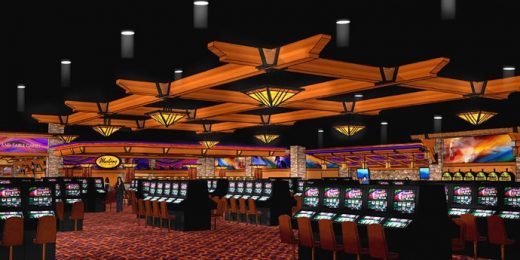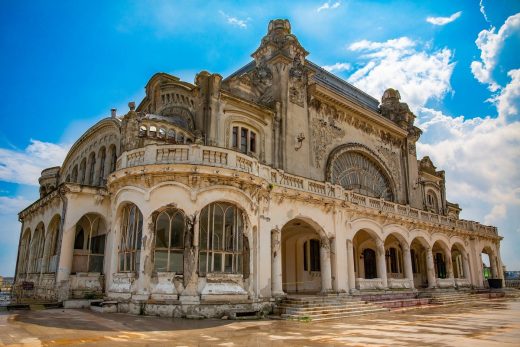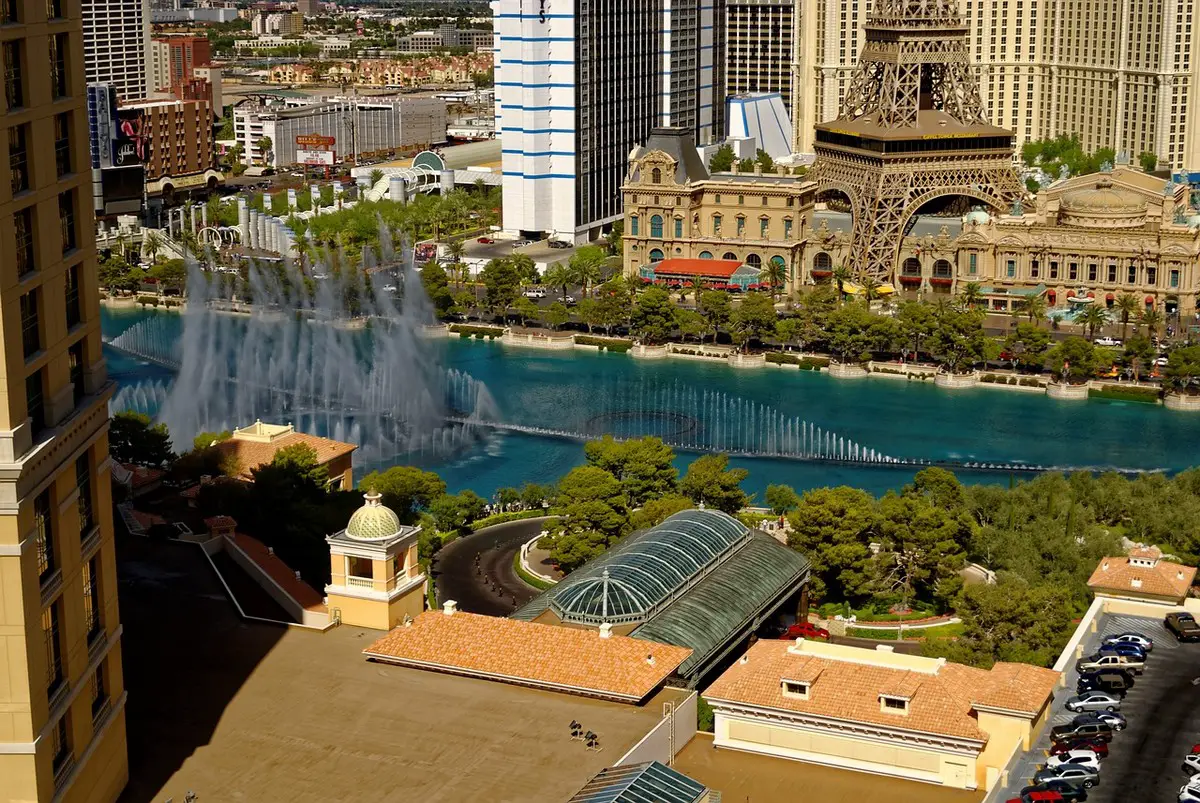How architecture can sway the odds, Casino buildings across the globe, Gambling building designs
How Architecture Can Sway The Odds
22 July 2023
Imagine walking into a casino. The vibrant colours, flashing lights, and compelling sounds beckon you into a different world. This world is meticulously designed to create an inviting, engaging and thrilling atmosphere, enticing you to stay, play, and spend.
Behind this mesmerizing environment lies the deliberate architecture of casinos, intentionally designed to influence player behaviour and shift the odds in the house’s favour.
Unable to offer players new free spins no deposit bonuses, like their virtual counterparts, land-based casino have physical design tricks up their sleeve. In this article, we explore the captivating world of casino architecture, revealing its strategic design elements and their psychological effects on players.
The History of Casino Architecture
To understand how casino architecture sways the odds, we first need to delve into its historical evolution.
Early Casino Design and Layout
The earliest casinos didn’t really focus much on architecture as a tool for influencing player behaviour. These venues, dating back to the 19th century, were more about social gatherings, luxurious interiors, and offering a glamorous environment for the elite to congregate and gamble. Think of them as more of private clubs or fancy villas, such as Casino de Monte-Carlo, with their architectural design meant to impress with luxury and exclusivity rather than influence player behaviour.
Evolution of Casino Architecture and its Psychological Purpose
However, as the popularity of gambling grew, so did the understanding of its profit potential. With Las Vegas emerging as a gambling hotspot in the mid-20th century, casino owners began to recognize the role architecture and design could play in maximizing this potential. It was around this time when the concept of casino design as a psychological tool began to take root.
One of the pioneering figures in this shift was Bill Friedman, a casino design consultant in the late 20th century. Friedman argued that a casino should be a maze of short, narrow passageways with low ceilings and minimal decor, aiming to keep gamblers focused on gambling. He proposed that the gaming areas should be intentionally confusing to navigate, encouraging players to get lost and, in doing so, stumble upon new areas to gamble.
In contrast, Roger Thomas, working for the Wynn Resorts, introduced a different approach in the early 21st century. He proposed the playground design – a comfortable, inviting environment with high ceilings, lush design elements, and natural light. Thomas believed that people were more likely to spend money when they felt comfortable and less aware of their spending habits.
Over time, casino owners and architects have experimented with these theories and more, refining their designs to create the immersive and engaging environments we see today. From the mesmerizing layout of the gaming floor to the strategic placement of amenities, every architectural element is precisely calculated to encourage players to gamble more and stay longer, ultimately swaying the odds in the casino’s favour.
The Psychology of Casino Design
Let’s delve deeper into the intricacies of casino design and how these aspects tap into our psychological tendencies to influence our behaviour.
The Importance of Layout and Navigation: The Maze vs. Playground Designs
As we’ve mentioned, there are two prevailing theories in casino design: the ‘maze’ and the ‘playground’. In a maze-style casino, the layout is complex, filled with short aisles, sharp turns, and gambling machines crammed in every available space. The idea is to make it hard for players to find their way out, causing them to pass by more games and, therefore, be tempted to keep playing.
On the other hand, the ‘playground’ design aims to provide a more enjoyable and less claustrophobic experience. These casinos often have high ceilings, open floor plans, and extravagant decor. The theory behind this design is that people gamble more when they’re in a more pleasurable environment, even if they are losing.
Ambience and Atmosphere: Lighting, Noise, and Décor
Lighting and noise play a crucial role in the casino atmosphere. Soft, warm lighting and the constant jingling sounds of slots and coin payouts create an inviting environment. These elements give the illusion of a festive environment where winning seems common, encouraging gamblers to bet more.
Furthermore, the decor, usually lavish and extravagant, adds to the overall sensation of a luxurious and exciting atmosphere, making players feel like they are part of an exclusive club. The comfort and opulence can make players feel more at ease with spending money.
Absence of Time Indicators: Clocks and Windows
You’d be hard-pressed to find a clock or a window showing the passage of time in a traditional casino. This design feature is intentional, aiming to make players lose track of time and keep them playing for as long as possible. In the timeless world of the casino floor, whether it’s 3 PM or 3 AM seems irrelevant.
Architectural Elements in Detail
Now that we understand the general psychological approach behind casino design, let’s examine some specific architectural elements and their influence on player behaviour.
Entrance Design: Creating the ‘Wow’ Factor
The first thing a player experiences is the entrance. Casinos often create a dramatic entrance, a spectacle that elicits a sense of wonder. Grand doors, impressive artworks, sparkling chandeliers, or cascading fountains—all create a first impression that the experience inside will be equally magnificent.
Gaming Floor Design: Guiding Players Towards High Profit Areas
Once inside, the layout of the casino floor is strategic. The most profitable games, like slot machines, are typically placed in high-traffic areas. On the other hand, table games, which tend to have lower house edges, are usually more secluded. The aim is to guide players, subtly and subconsciously, towards games where the house has a higher chance of winning.
Location and Positioning of Amenities (Restaurants, Restrooms, etc.)
Similarly, amenities like restaurants, bars, and restrooms are usually located deep within the casino. This design forces players to walk past a variety of gaming options to reach these facilities, tempting them to play more.
Slot Machine Placement and Arrangement
Even the arrangement of slot machines is not random. High-payout machines are often placed in highly visible areas, so when players see others winning, they are more likely to play themselves. In contrast, machines with lower payouts are often placed in less conspicuous areas.
In conclusion, every element in a casino, from the moment you walk through the doors to the placement of each slot machine, is meticulously planned and designed to keep you entertained, comfortable, and willing to play more. The fascinating intersection of architecture and psychology in casino design is a testament to how our environment can influence our decisions and behaviour.
The Role of Architectural Nuances in Player Behaviour
Now that we’ve explored the key elements of casino architecture, let’s delve into how these details can subtly affect a player’s actions and decisions.
How Design Influences Time Spent Within the Casino
The primary goal of a casino’s architectural design is to keep patrons inside for as long as possible. The strategies we’ve discussed, such as the maze-like layout, absence of time indicators, and deep placement of amenities, all serve to disorient the player and blur the passage of time. The longer a player stays inside a casino, the more likely they are to continue betting, which of course increases profits for the casino.
The Impact on Player Spending and Gambling Habits
Casino architecture is also designed to encourage higher spending. The playground-style layout provides a luxurious and comfortable environment, making patrons feel more relaxed about spending money. The strategic placement of high-profit games and the visible celebration of wins (particularly on slot machines) encourage the belief that winning is common, prompting patrons to spend more in hopes of a similar payout.
Encouraging Continuous Play: Seating, “Winning” Sounds, and Near-Miss Features
Casinos also employ architectural design to promote continuous play. Comfortable seating at slot machines and game tables make it easy for players to stay for long periods. The constant, vibrant sounds of winning from slot machines create an atmosphere of excitement and the illusion of frequent payouts. Some slot machines are even designed with ‘near-miss’ features, where players nearly win, which encourages them to keep playing in hopes of winning next time.
The Illusion of Control and Perceived Chances of Winning
Interestingly, many casinos use design elements to give players a sense of control, which can affect their betting behaviour. For example, having a dice to roll or a wheel to spin (like in roulette) can make a player feel like they have some control over the outcome, even though these are games of pure chance. This illusion of control can result in more confident betting and increased playtime.
Case Studies: Successful Casino Designs and Their Impact
Understanding the theory behind casino architecture is one thing, but seeing it in action brings it to life. Let’s look at a few examples of casinos that have effectively used architectural design to influence player behaviour.
A Look at Renowned Casinos and Their Unique Architectural Features
The Bellagio in Las Vegas, known for its elegance and luxury, is an excellent example of the playground design. The casino greets patrons with an awe-inspiring fountain show, followed by a lavish interior complete with high ceilings, stunning artwork, and an indoor botanical garden. This high comfort environment is designed to encourage patrons to gamble more freely.
In contrast, older casinos like the Golden Nugget used the maze-like layout to keep patrons inside longer. Low ceilings and a maze of slot machines and gaming tables make navigation challenging and subtly encourage more gambling.
Evidence of Design Influencing Player Behaviour and Profits
Studies have shown that these architectural tactics are effective. For example, research published in the Journal of Gambling Studies found that patrons reported a higher intention to gamble in playground-style casinos compared to gaming-focused (or maze-like) casinos.
The comfortable and pleasurable design of the playground model translated into more playtime and increased betting.
Meanwhile, casinos with a more confusing layout have also found success in keeping patrons inside longer, leading to increased playtime.
In both design styles, the architecture of the casino plays a significant role in keeping patrons engaged and prompting higher spending, proving the power of architecture in swaying the odds.
How architecture can sway the odds Conclusion
Every detail, from the lighting to the layout, is carefully designed with a clear intention—to keep you entertained, comfortable, and willing to spend. The powerful interplay between architecture and psychology is evident in every corner of a casino, subtly influencing your perception, mood, and behaviour.
As we’ve seen, the role of architecture in casinos goes far beyond aesthetics. It’s a psychological tool that, when used responsibly, can enhance the gambling experience while ensuring the odds always lean in the house’s favour.
Comments on this guide to How architecture can sway the odds article are welcome
Casino Buildings
Casino Building Designs
5 most beautiful casino buildings in world

Casino Architecture Design Guide

Buildings
Contemporary Property Articles – recent architectural selection from e-architect below:
London Architecture Designs – chronological list
Comments / photos for the How architecture can sway the odds page welcome







